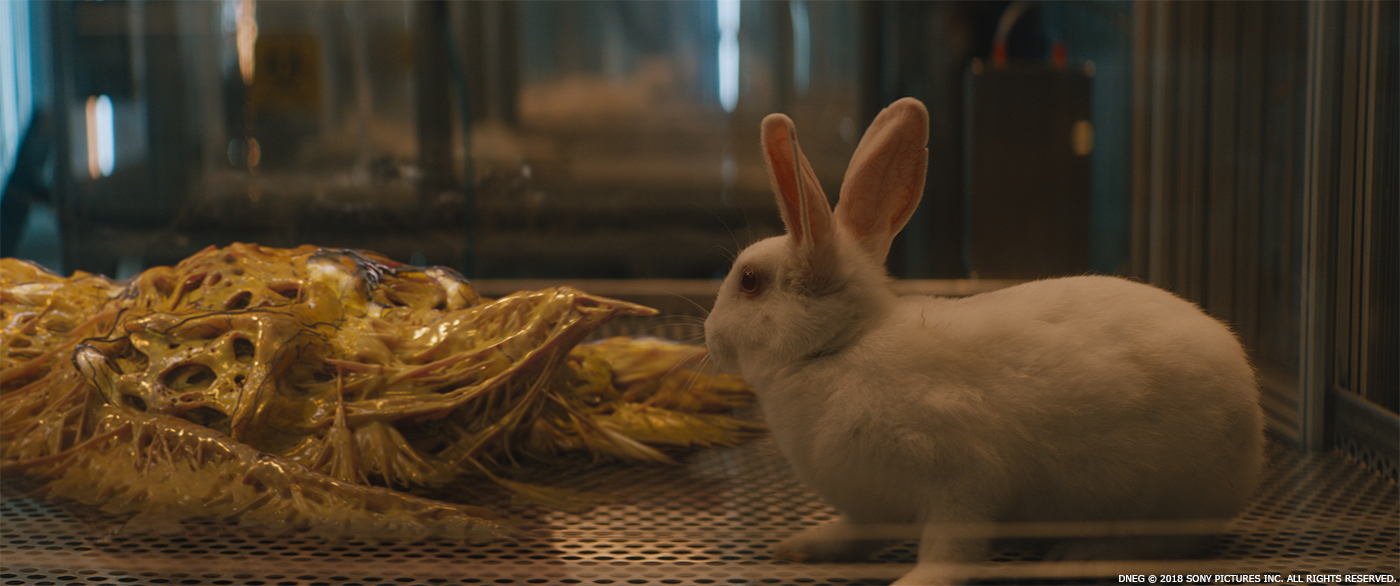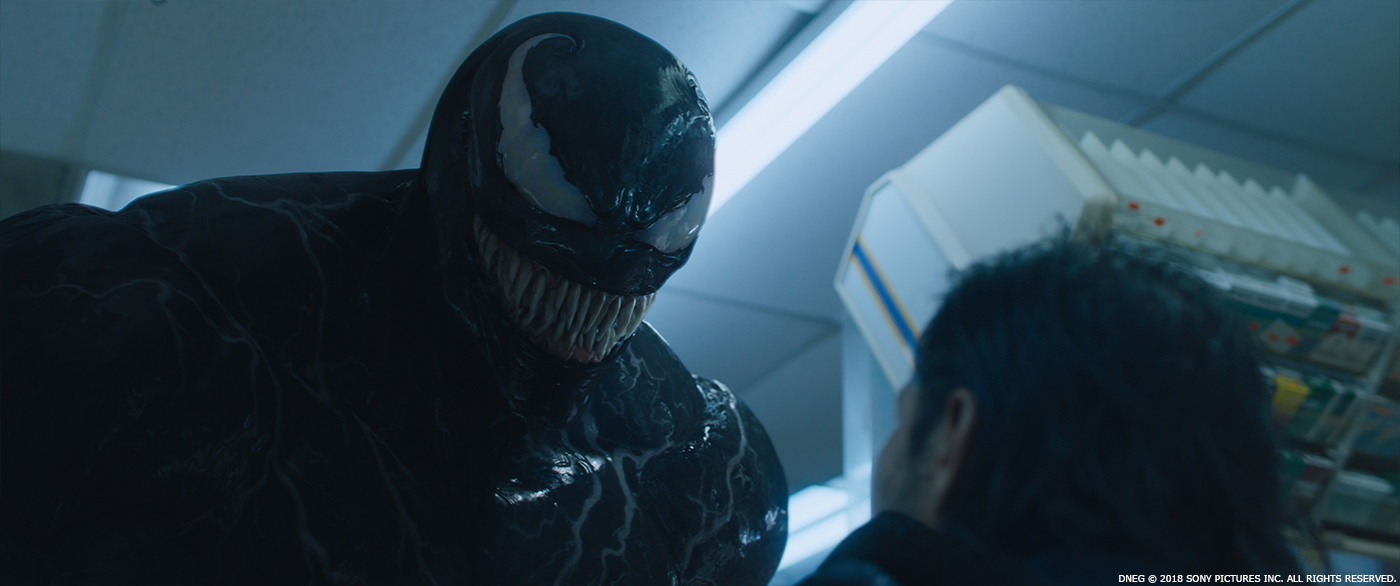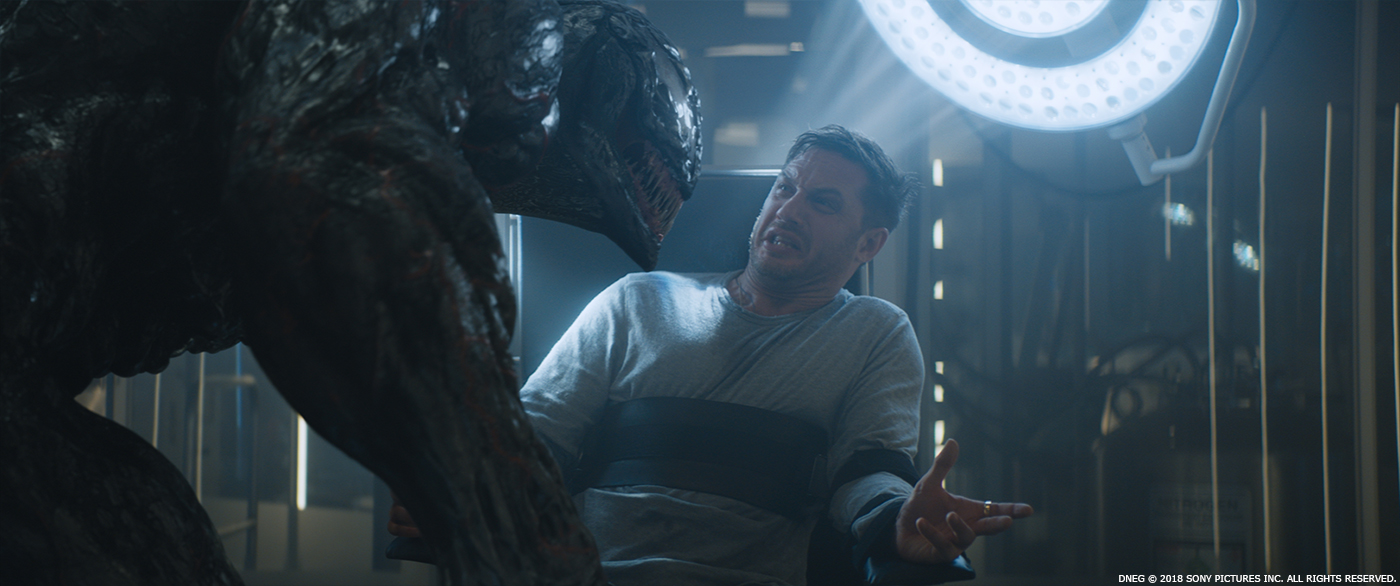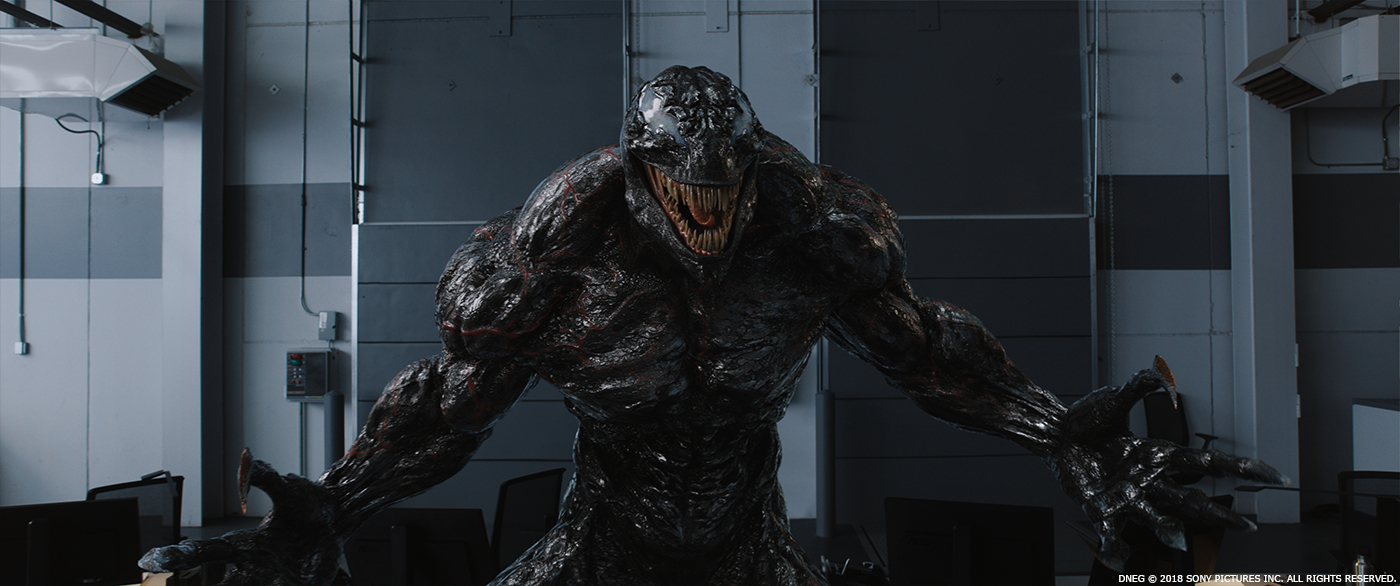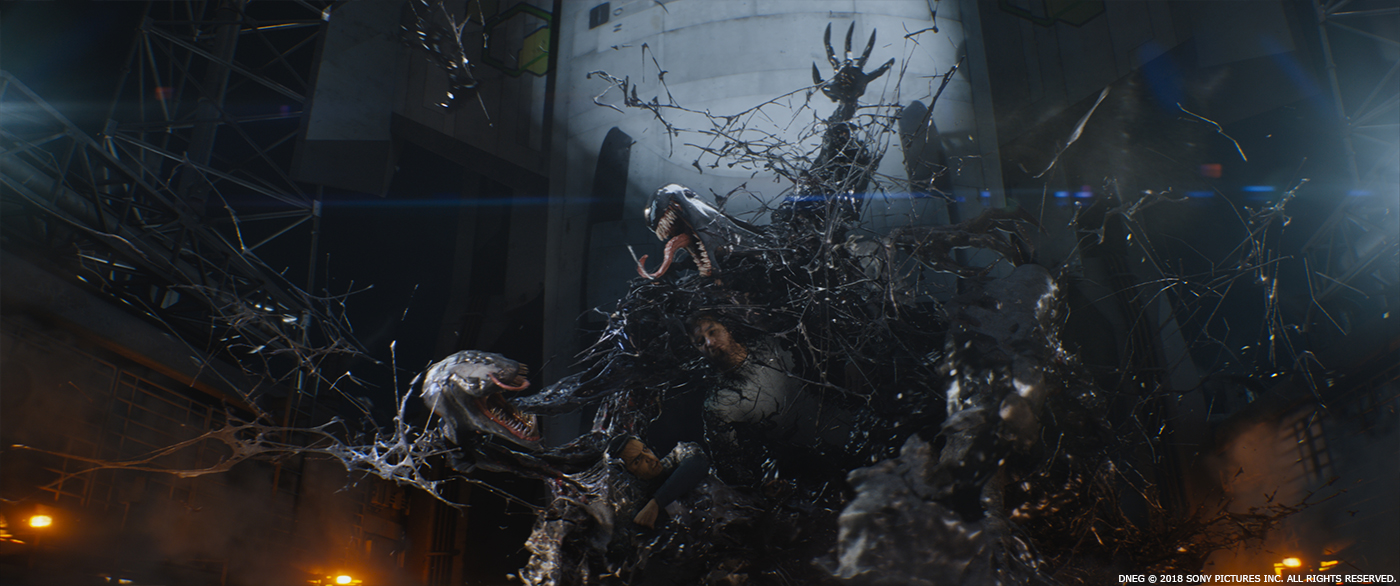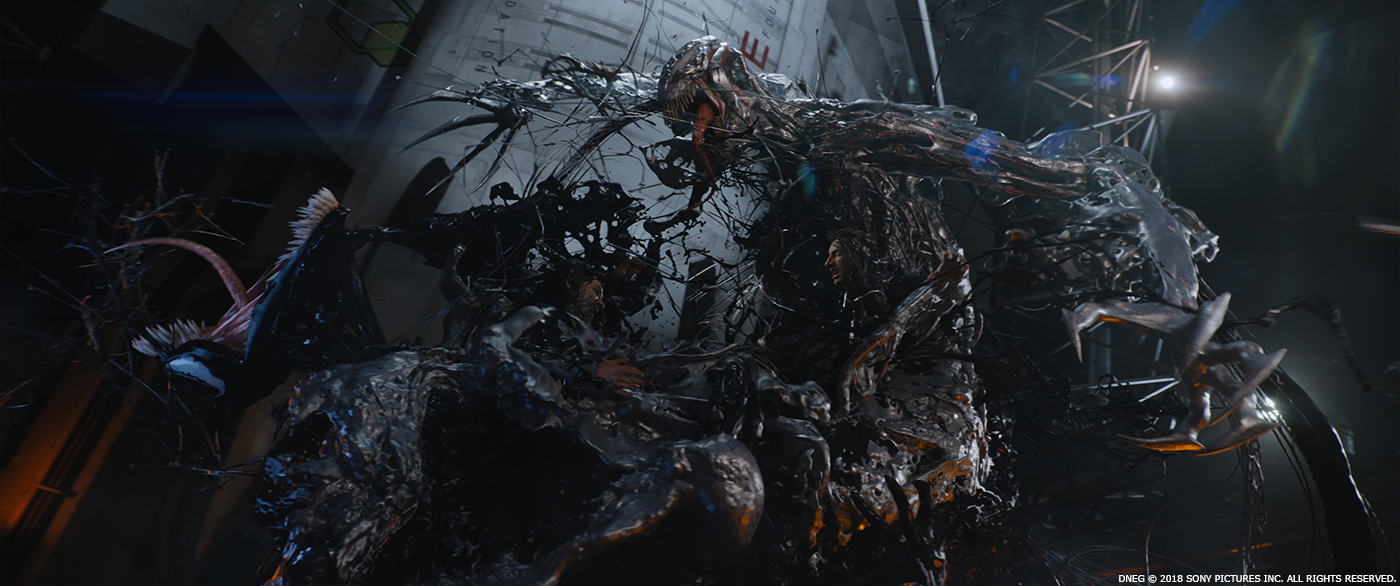In 2015, Paul Franklin talked to us about DNEG’s work on INTERSTELLAR. He then worked on MISSION: IMPOSSIBLE – ROGUE NATION, THE ONES BELOW, CAPTAIN AMERICA: CIVIL WAR, BLADE RUNNER 2049 (as Visual Effects Creative Director) and FIRST MAN (as Visual Effects Consultant).
How did you and DNEG get involved on this show?
Sony approached DNEG and myself in the spring of 2017. I read the script and met with Ruben Fleischer – what struck me was the chance to make a comic book movie with a difference, where the character is not so clear cut as in a lot of the other movies that are out there. Ruben wanted the film to be exciting and engaging, but he also wanted it to have an edge, that marked it out from the rest of the field.
What was your feeling to work on such an iconic character?
Over the course of my career I have been lucky enough to work on a number of iconic characters – my focus is always the story as it’s important not to let yourself get overwhelmed by the provenance of the character. But I always keep in mind that the characters mean so much to fans out there who are heavily invested in them, so whilst it’s important to serve the needs of the audience as a whole, it’s also key to make sure that you respect the fans whenever you can!
How was the collaboration with director Ruben Fleischer?
Ruben was great. VENOM was the first time that he had worked on a movie with so much VFX and where VFX was essential to the story telling, but Ruben was clear from the outset as to what kind of movie he wanted to make and the story that he wanted to put on the screen. He referenced a lot of the current crop of superhero films, but also talked about classics like John Carpenter’s THE THING and AN AMERICAN WEREWOLF IN LONDON, which became a bit of a touchstone for me as it’s a film that I grew up with in my teens during the 1980s. Ruben was never overly-prescriptive – he pointed us in the right direction and we got on with realising the VFX for the film.
What was his expectations and approaches about the visual effects?
Ruben was clear that he wanted VENOM as a movie to be able to hold its head up with all the other comic book films that are out there, but he also was keen that we shouldn’t just imitate what’s out there. He was keen that Venom on the screen should be as unique a presence as he is in the comic books.
How did you organize the work with VFX Supervisor Sheena Duggal and your VFX Producer?
Sheena came on board for a few during prep to shoot the San Francisco aerial sequences and also to help start the prep for the extensive second unit action shoots. Sheena then rejoined the show when we started post in the spring of 2018 – the main VFX work was carried out at DNEG’s main office in London which is where I am usually based so I went back to the UK to work with the team on a day to day basis whilst Sheena focused on maintaining VFX’s relationship with editorial in LA, working with Ruben and the editors on a daily basis. We also had a small in-house team of compositors handling 2D-only work in LA so Sheena looked after those guys as well. Later on we had a previs team set up in the LA post production office and Sheena worked with them as well. Mark Soper, our VFX producer was based in LA for post, dealing with the day to day running of the show and working with Sony. I spent a lot of time shuttling back and forth between London and LA making sure that everything was working well between the two sites.
How did you split the work among the DNEG offices?
DNEG London served as the hub for the show with work also being carried out in Mumbai and Vancouver. Sequences and even shots were shared across the sites with regular daily reviews carried out both offline and live via cineSync and a DNEG proprietary tool called Clip which forms the heart of the playback/review system. All the sites are linked on a common network/database so shots and data could be transferred between the sites allowing us to move work about efficiently. All the work is tracked via a proprietary DNEG database called Ivy which is managed through Shotgun and a proprietary suite of viewing/management tools. Each site could run shots from end to end, but sometimes it made sense to put the work in specific sites where the expertise was concentrated, so for instance, the majority of creature animation was in London, but we also had animation teams in Mumbai handling tentacles and a separate animation team in Vancouver working on standalone scenes.
Can you tell us more about the previz and postviz work?
During prep previz was split primarily between DNEG’s in-house team who handled the apartment tentacle fight and the bike chase. The Third Floor in Los Angeles and – to a lesser extent – in London looked after a number of other standalone scenes but their main work was the epic fight between Venom and Riot at the rocket base. All previs was sent over to Atlanta where the production was based and I worked with the VFX editorial team to put the sequences together. As the Venom/Riot fight developed we extended it with animatics that came out of DNEG’s art department which defined the look and scope of the extraordinary “merge fight” where the symbiotes blend together.
How did you work with the art department for the design of Venom?
The character design for Venom was initially worked on by Legacy Studio. Their designs were then taken by DNEG’s art department who continued the process before handing off to the DNEG animation and creature teams who finalised the design.
Can you explain in detail about his creation?
We spent a lot of time looking at the way that different artists had approached the character over the years. It soon became apparent that each artist had a unique take on the character and that graphic stylisations were used to show Venom’s amorphous abilities, something that we wouldn’t have the luxury of doing. However, we needed to honour the intention of the artists and speak to the characteristics that the fans were hoping to see in our interpretation. We devised an approach underpinned by a relatively traditional character animation rig which allowed us to block out the scenes in a fairly standard way, but which was then enhanced through the use of a complex creature FX process – at its most minimal, the FX created the strands of goo around Venom’s mouth and the rippling edges of his eyes, but at its most extreme it produced tentacles, shields and lattices of goo that extended the character’s abilities.
How does his dark and reflective skins affects your work?
In the comics Venom is usually rendered as a silhouette with limited highlights to define his body shape – there’s no real indication as to what Venom’s surface texture actually is and certainly no consistency across the few images that do give a sense of what his surface might actually be. We decided to go with a very slick wet surface, but rather than make it super smooth we wanted to hint at the complex biology within the character so we devised a complex multi-layered look with areas of varying wetness and viscosity, this helped us to avoid him looking like he was wrapped in foil or vinyl. We realised pretty quickly that we would have to light him primarily through reflection rather than direct illumination to avoid him “graying out” and going low-contrast. The primary reflections in the live action scenes came from the HDRI maps captured on set, but we generally found that they made him look like he was in the middle of sports arena with floodlights all around him so we had to dial them back quite a bit and then add subtle reflection cards to bring out features such as his jawline or to get a read on the wrinkling of his forehead as he changed expression. We found that every shot was a bespoke setup as even slight changes in his position would greatly affect the way that his surface reflections read.
Can you tell us more about his rigging and animation?
The underlying rig for Venom’s body was relatively straight forwards with muscle and skin simulations being pretty essential in conveying his physical presence. Over time we figured out which poses looked best and how to make the most of Venom’s considerable physique in the shots. We quickly found that we needed to stay away from poses and animations which made him look too much like a man in a suit!
Did you received specific indications and references for his animation?
For some of the live action scenes we had a very tall stunt double who served as a framing guide and who gave some good interaction reference for the shots where Venom was holding onto other actors in the scene, and we looked at a lot of the poses in the comics, doing our best to incorporate them in the animation, but for the most part it was down to our animation team to figure out his body language and make him work within the context of the shots. Venom is so powerful and so fast that there wasn’t that much that could be done on set for that other than rely on the timing guides produced in animation.
Can you tell us more about his facial animation?
The big challenge was Venom’s face which, whilst being roughly human-like with a clearly defined mouth and eyes, but the extreme stylisation of his features posed quite a few animation problems. Venom’s eyes were especially challenging as they are so huge, covering a sizeable part of the upper skull – the eyes had to be able to slide over the curvature of the skull whilst providing recognisable shapes that would sell Venom’s acting without looking weird, effectively bringing the stylisation of the comic books into the “real” world of the film. Another big thing to deal with – literally – was Venom’s distinctive lascivious tongue. In the comics the tongue is ever-present, flailing around all the time in expressive curling shapes. However, we had a lot of dialogue to deliver so we needed to pull the tongue back, keeping it for moments of emphasis such as in the fight sequences – we couldn’t have the tongue out all the time as it just didn’t work with his speech.
The symbiotes have specific and constantly moving shapes. How did you handle this aspect?
The representations of the symbiotes in the comics were almost abstract, with no real consistency in any of the drawings – we decided to embrace that so we spent a lot of time looking at things like time-lapse photography of slime moulds, footage of under sea creatures such as jellyfish and microscopy of things like amoeba which had structural aspects in common with what we intended for the symbiotes. We eventually developed an animation rig that enabled the animators to animate a constantly shifting central body that could move in any direction, climb any surface and adopt any shape. Once the shot was blocked out it was then handed off to the FX animation team who added complex layers of rolling tissue that enhanced and extended the underlying animation in the rig. Complex strands of connective tissue constantly formed and reformed between all the moving components and layers of fluid simulation added a satisfyingly gloopy aspect that straddled the divide between something solid and liquid.
Did you use procedural tools for their animations?
The FX animation team used layered simulations to create all of the symbiotes’ surface effects and to give the sense of an inner structure that could be seen through the apertures and orifices in the creatures’ bodies.
How did you create the shots in which we see the symbiotes eyes on the hosts?
The eyeball effect was a combination of careful rotoscoping to isolate the eyes and then layers of texture animation were added within the matte area – all of this was created within Nuke rather than in the full 3D toolset. Depending on which symbiote was being featured the colours would change – Riot was the trickiest as it was difficult to sell the idea of gunmetal in the eyes without them going grey and dull, in the end we added a bit of a silver sparkle to keep it metallic.
Can you tell us more about the really quick apparitions of Venom when he ears ultrasonics?
The “sonic freakout” effect went through a number of iterations. At the outset we had a full three-dimensional effect extruding out of the skin and some of that idea can still be seen in the moment when Eddie is first affected by the sounds coming from the MRI machine, but for the main effect we decided to go with something a little more ambiguous with the sense of a ghostly version of Venom being vibrated out of Eddie’s body. We tracked a proportionally matched version of Venom to Eddie’s movements and then created a semi-transparent blurry vibration effect in Nuke, selectively revealing some of Venom’s features – such as his teeth – at key moments during the close ups.
There is an exciting car chase though San Francisco. How did you approach this big sequence?
The bike chase started with detailed previs created at DNEG. This gave us a great place to start from and helped the stunts and 2nd Unit team understand what Ruben was hoping to get in the actual sequence. 2nd Unit then picked this up and ran with it, creating a lot of their own previs and story boards in addition to what had already been done. In post production the team from The Third Floor created layouts for the tentacle animations and other action beats. DNEG then took all of this and pushed it on further in VFX animation.
How did you work with the SFX and Stunts teams?
The main thing we provided to Stunts and SFX was our previs. In the case of Stunts Chris O’Hara (Stunt coordinator) took everything into “stunt vis”, creating short live action sequences with place-holder animations to tell the story. When it came to filming for real we positioned additional witness cameras on the set, synchronised to the time code coming out of the sound desk. The witness cameras helped us to understand the movement of bodies and the main movie camera – essential to getting spot-on registration of the VFX elements with the live action.
Can you explain in detail about your work on this sequence?
The main thing was tracking the movement of the bike through the streets so that we could add the goo effects to Eddie’s arms (a late addition to the sequence so nothing was shot in camera). We also replaced the rider’s head in most shots with a digital version of Tom Hardy’s head – that required a lot of very careful work to hopefully ensure something that would never be noticed by the audience. The most complex part of the chase is the “SUV sandwich” where Eddie is in danger of being crushed between two of the pursuing vehicles. This beat was shot entirely on a blue-screen stage with the cars being moved around on platforms relative to the movement of the bike. DNEG added in all the glass into the cars, the travelling backgrounds, the wheels of the vehicles (including the motorbike) and, of course, the webs of gooey tentacles that Eddie has coming out of his body, holding the cars at bay.
Did you need you recreate some San Francisco places?
The chase was shot mostly on the streets of Atlanta, Georgia, but several key moments in the sequence were filmed on location in San Francisco by 2nd Unit. The only thing we really had to deal with is the removal of the very large Coca Cola signs that are seen around Atlanta (the home of Coca Cola).
We discover many locations in the movie and especially the Life Foundation building. How did you create these various places?
The Life Foundation building started out as a design from production designer Oliver Scholl’s art department. DNEG took this and then modified it to integrate into the location filmed during our aerial shoot – the Marin Headlands just north of San Francisco itself. The Life Foundation building featured a faceted glass exterior with a complex brushed aluminum framework. At night the whole building is lit up with multiple layers of internal floors and offices – depending on what the movement of the camera was we achieved this through a combination of 3D models and 2D matte painted artwork projected onto 3D geometry.
The final fight features Venom against Riot. How did you choregraph this fight?
The fight started out as an extensive previs from The Third Floor. In post, this was picked up by the DNEG animation team in London who extended and enhanced the action, making the most of the differing fighting styles of the two creatures – Venom is lithe and supple whereas Riot is heavy and brutal.
How did you create the various weapons used by Riot?
Some of the weapons started out in previs with The Third Floor but others were created by DNEG during post. In most cases the weapons are grown out of Riot’s body through a series of FX simulations which give an organic feel to the items which then resolves into a hard, sharp-edged cutting blade or spiked wrecking ball.
The sequence ends with a massive explosion over the water. How did you create this big FX elements?
The explosion of the Life Foundation space shuttle is a combination of 3D FX simulations which give the underlying structure of the effect and then extended with the use of practical pyrotechnic elements.
Can you tell us more about the various FX simulations?
The heaviest bit of simulation work in the fireball explosion is in the moment where Venom is being burnt away by the flames as he does his best to protect Eddie within him. The FX animation team “liquified” Venom’s surface and then added bubbling, sizzling and charring black symbiote flesh. Finally, as Venom is burning away into ashes, he extrudes out great vines of gooey flesh which form up into a combination parachute and fire shield – this required very precise control over all the simulations which had to be hooked into the action of the underlying animation rig used to create the effect of the parachute tentacles growing out of Eddie’s body.
Beside DNEG, how did you split the work amongst the others vendors?
The only other VFX vendor on the show was the in-house team of compositing artists in LA who were overseen by Sheena Duggal, all other work was completed by DNEG. Fortunately, I have been part of the furniture at DNEG for the last 20 years so I have a pretty good relationship with all the artists involved!
Can you tell us more about your collaboration with their VFX supervisors?
I was very lucky to be able to work with people that I have known for years – one of the advantages of being part of DNEG.
Which sequence or shot was the most complicated to create and why?
The most complex sequence was the “merge fight” at the end of the Riot/Venom fight in which the two symbiotes merge into a raging sea of alien flesh. As they tumble and tear at each other they reveal the two human hosts within who are held within, so we end up with a roiling twisting fight between four creatures that moves all around the area in a complex, elastic fashion.
Is there something specific that gives you some really short nights?
Pretty much all of it kept me on my toes at one point or another! A show like VENOM pushes you to your limits as you constantly try to beat what you’ve just done.
What is your favorite shot or sequence?
My favourite sequence in the film is when Venom releases himself from the side of the spaceship and then drops down to slash open the fuel tanks with Riot’s discarded blade – I think it’s a great bit of clear linear story telling which provides an unexpected twist at the end of it all.
What is your best memory on this show?
Getting to work with so many great people on a movie that’s all about pure fun at the end of the day.
How long have you worked on this show?
I started at the end of June 2017 and delivered in the last week of September this year – pretty quick, all things considered.
What’s the VFX shots count?
I think we ended up with somewhere in the region of 1200 shots in the film.
What was the size of your team?
In total, the VFX team numbered well over 1400 people, the vast majority of whom were part of the DNEG setup. Stay for the credits on the movie and you can see how many people were involved!
What is your next project?
Right now I’m taking it easy and not looking at anything specific for the time being!
A big thanks for your time.
WANT TO KNOW MORE?
DNEG: Dedicated page about VENOM on DNEG website.
© Vincent Frei – The Art of VFX – 2018


